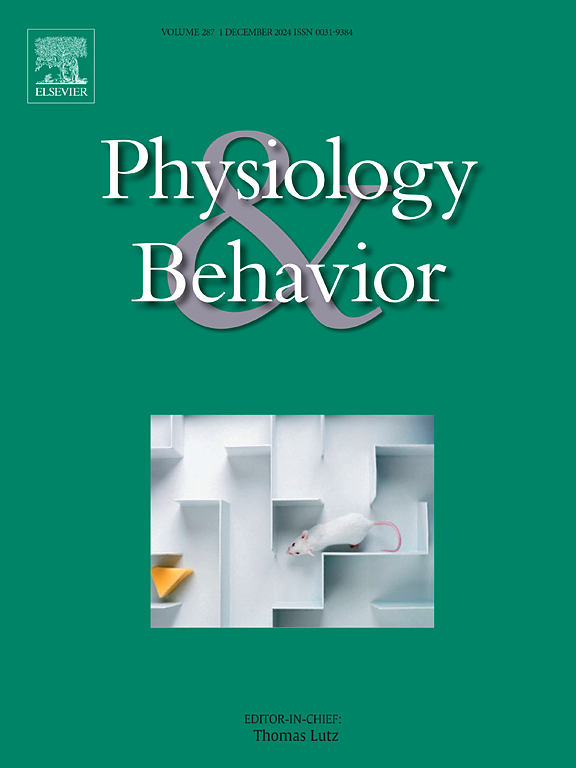Sex-specific behavioral, cardiac, and neuroendocrine responses to repeated witness social stress in adult rats
IF 2.4
3区 医学
Q2 BEHAVIORAL SCIENCES
引用次数: 0
Abstract
In humans, sex disparities exist in the prevalence of social stress-related disorders, yet our understanding of the predisposing factors and underlying mechanisms is still elusive. Also at the preclinical level, the investigation of sex differences in social stress responses is limited. In this study, adult male and female wild-type Groningen rats were repeatedly exposed to witness social defeat stress (WS) to assess sex-specific behavioral, neuroendocrine, and cardiac responses to the same social stress paradigm. Male and female rats bore witness to an aggressive social defeat episode between two males for nine consecutive days or were exposed to a control (CTR) procedure. Stress-related parameters were assessed in correspondence to the first and last WS/CTR exposure and also during subsequent exposure to the stress context alone in the absence of social defeat. During WS, rats of both sexes displayed larger amounts of burying behavior and smaller amounts of rearing and grooming behaviors, but with a greater extent in female witnesses. Cardiac autonomic responses to WS were similar between the sexes, yet only females displayed higher plasma corticosterone levels after the first WS exposure compared to CTRs, and had a larger corticosterone increase than male witnesses upon repeated WS. Exposure to the stress context alone (i.e., without the presence of the aggressive resident rat) elicited greater amount of burying behavior and more pronounced and persistent tachycardic responses in females than males with a history of WS. Our findings suggest sex-disparities in the response of adult rats to WS at multiple behavioral, cardiac, and neuroendocrine levels, highlighting the utility of this social stress paradigm for investigating predisposing factors and pathophysiological mechanisms underlying sex-specific vulnerabilities to stress-related pathologies.
成年大鼠对重复目击社会压力的行为、心脏和神经内分泌反应具有性别特异性。
在人类中,与社会压力有关的疾病的发病率存在性别差异,但我们对其诱发因素和内在机制的了解仍然很有限。同样,在临床前水平上,对社会压力反应中性别差异的研究也很有限。在这项研究中,成年雄性和雌性野生型格罗宁根大鼠被反复暴露于目睹社会失败压力(WS)下,以评估性别特异性行为、神经内分泌和心脏对相同社会压力范式的反应。雄性和雌性大鼠连续九天见证两只雄性大鼠之间的攻击性社交失败事件,或接受对照(CTR)程序。在第一次和最后一次WS/CTR暴露中,以及随后在没有社交失败的情况下单独暴露于应激环境中时,都会对应激相关参数进行评估。在WS过程中,雌雄大鼠都表现出较多的埋藏行为和较少的饲养和梳理行为,但雌性大鼠表现得更为明显。雌雄大鼠对WS的心脏自律神经反应相似,但只有雌性大鼠在首次暴露于WS后的血浆皮质酮水平高于CTR大鼠,而且在重复暴露于WS后,雌性大鼠的皮质酮升高幅度大于雄性大鼠。与有 WS 史的雄性目击者相比,雌性目击者在单独暴露于应激环境下(即没有攻击性宿主大鼠在场的情况下)会引起更多的埋藏行为,以及更明显和更持久的心动过速反应。我们的研究结果表明,成年大鼠在行为、心脏和神经内分泌等多个层面上对WS的反应都存在性别差异,这凸显了这种社会应激范例在研究性别特异性易患应激相关病症的易感因素和病理生理机制方面的实用性。
本文章由计算机程序翻译,如有差异,请以英文原文为准。
求助全文
约1分钟内获得全文
求助全文
来源期刊

Physiology & Behavior
医学-行为科学
CiteScore
5.70
自引率
3.40%
发文量
274
审稿时长
47 days
期刊介绍:
Physiology & Behavior is aimed at the causal physiological mechanisms of behavior and its modulation by environmental factors. The journal invites original reports in the broad area of behavioral and cognitive neuroscience, in which at least one variable is physiological and the primary emphasis and theoretical context are behavioral. The range of subjects includes behavioral neuroendocrinology, psychoneuroimmunology, learning and memory, ingestion, social behavior, and studies related to the mechanisms of psychopathology. Contemporary reviews and theoretical articles are welcomed and the Editors invite such proposals from interested authors.
 求助内容:
求助内容: 应助结果提醒方式:
应助结果提醒方式:


